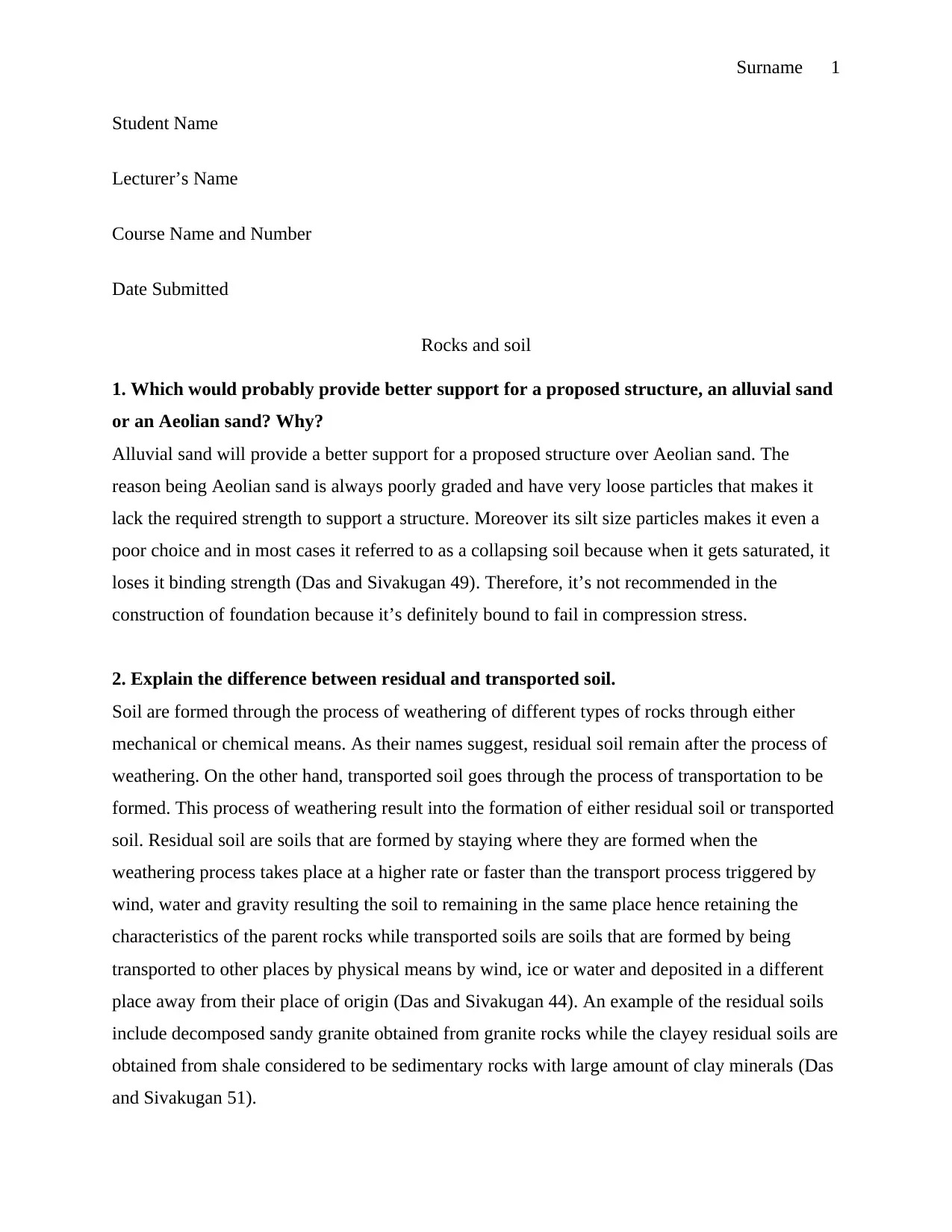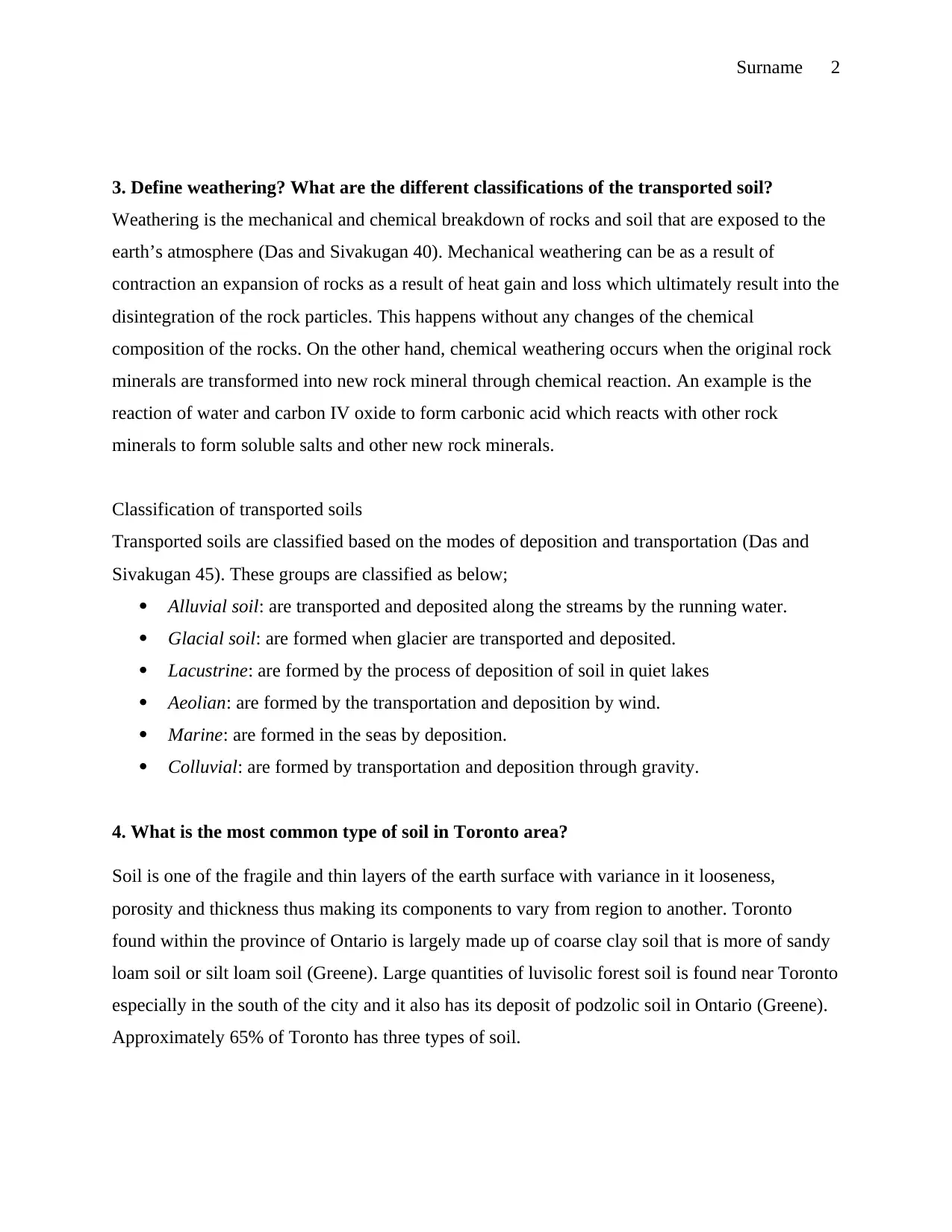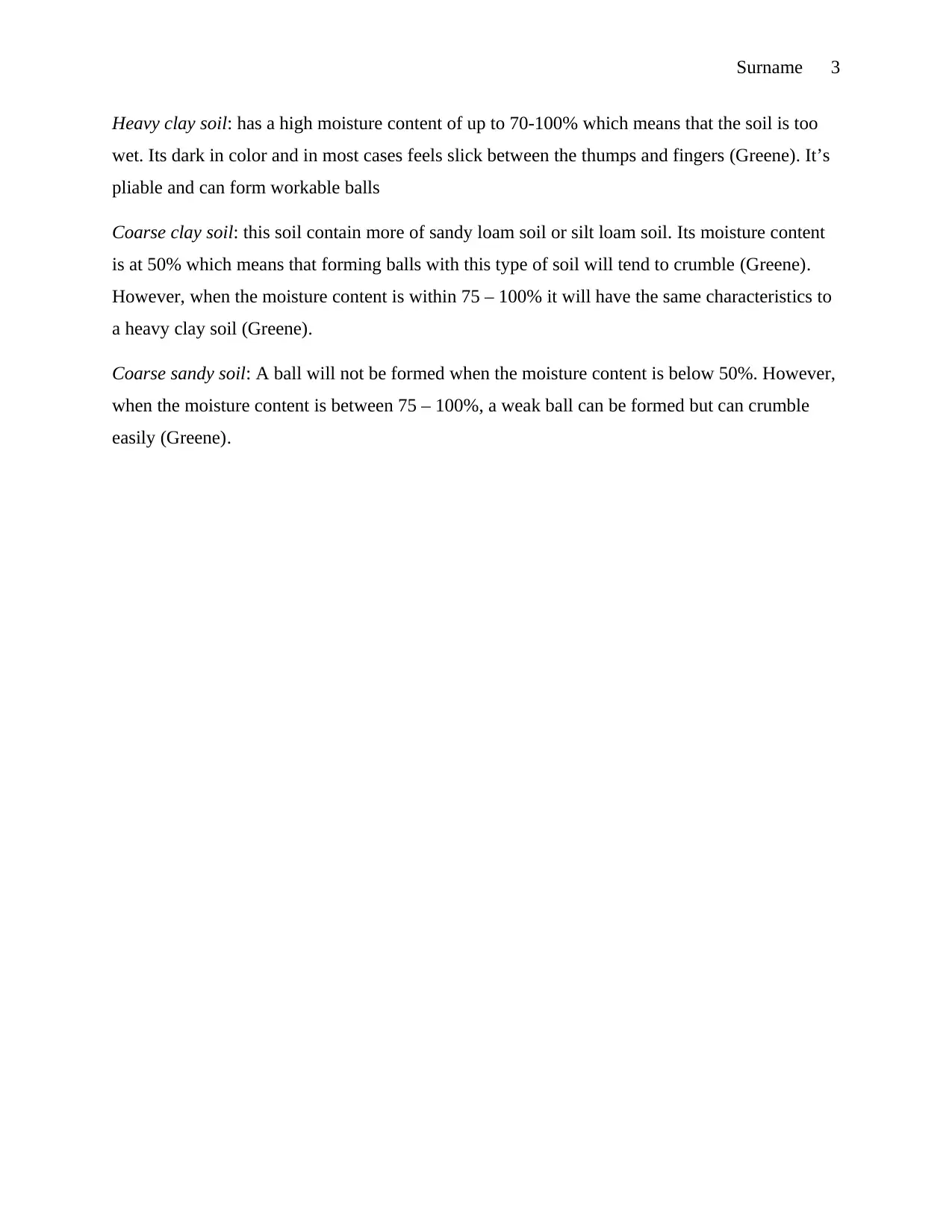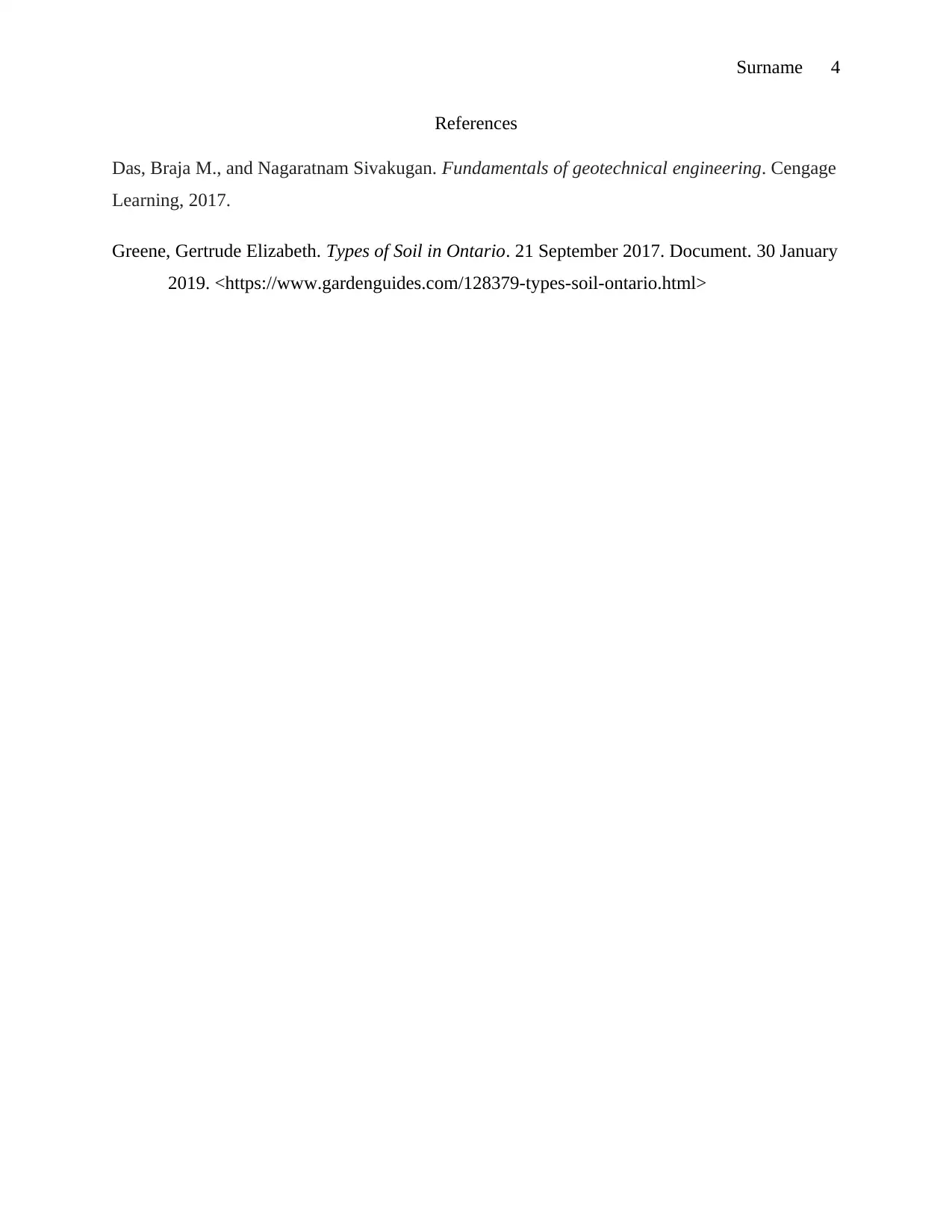CE 2J4 Rocks and Soils Assignment: University of Toronto, Jan 2019
VerifiedAdded on 2023/04/25
|4
|948
|287
Homework Assignment
AI Summary
This document presents a completed civil engineering assignment addressing key concepts in rocks and soils. The assignment explores the comparative support provided by alluvial and aeolian sands, explaining the superior structural support offered by alluvial sand due to its better grading and particle arrangement. It differentiates between residual and transported soils, detailing their formation processes and characteristics, and defines weathering, outlining mechanical and chemical processes. The assignment also classifies transported soils based on their deposition methods (alluvial, glacial, lacustrine, aeolian, marine, and colluvial). Finally, it investigates the most common soil types in the Toronto area, identifying heavy clay, coarse clay, and coarse sandy soils, and referencing the sources used for this research.

Surname 1
Student Name
Lecturer’s Name
Course Name and Number
Date Submitted
Rocks and soil
1. Which would probably provide better support for a proposed structure, an alluvial sand
or an Aeolian sand? Why?
Alluvial sand will provide a better support for a proposed structure over Aeolian sand. The
reason being Aeolian sand is always poorly graded and have very loose particles that makes it
lack the required strength to support a structure. Moreover its silt size particles makes it even a
poor choice and in most cases it referred to as a collapsing soil because when it gets saturated, it
loses it binding strength (Das and Sivakugan 49). Therefore, it’s not recommended in the
construction of foundation because it’s definitely bound to fail in compression stress.
2. Explain the difference between residual and transported soil.
Soil are formed through the process of weathering of different types of rocks through either
mechanical or chemical means. As their names suggest, residual soil remain after the process of
weathering. On the other hand, transported soil goes through the process of transportation to be
formed. This process of weathering result into the formation of either residual soil or transported
soil. Residual soil are soils that are formed by staying where they are formed when the
weathering process takes place at a higher rate or faster than the transport process triggered by
wind, water and gravity resulting the soil to remaining in the same place hence retaining the
characteristics of the parent rocks while transported soils are soils that are formed by being
transported to other places by physical means by wind, ice or water and deposited in a different
place away from their place of origin (Das and Sivakugan 44). An example of the residual soils
include decomposed sandy granite obtained from granite rocks while the clayey residual soils are
obtained from shale considered to be sedimentary rocks with large amount of clay minerals (Das
and Sivakugan 51).
Student Name
Lecturer’s Name
Course Name and Number
Date Submitted
Rocks and soil
1. Which would probably provide better support for a proposed structure, an alluvial sand
or an Aeolian sand? Why?
Alluvial sand will provide a better support for a proposed structure over Aeolian sand. The
reason being Aeolian sand is always poorly graded and have very loose particles that makes it
lack the required strength to support a structure. Moreover its silt size particles makes it even a
poor choice and in most cases it referred to as a collapsing soil because when it gets saturated, it
loses it binding strength (Das and Sivakugan 49). Therefore, it’s not recommended in the
construction of foundation because it’s definitely bound to fail in compression stress.
2. Explain the difference between residual and transported soil.
Soil are formed through the process of weathering of different types of rocks through either
mechanical or chemical means. As their names suggest, residual soil remain after the process of
weathering. On the other hand, transported soil goes through the process of transportation to be
formed. This process of weathering result into the formation of either residual soil or transported
soil. Residual soil are soils that are formed by staying where they are formed when the
weathering process takes place at a higher rate or faster than the transport process triggered by
wind, water and gravity resulting the soil to remaining in the same place hence retaining the
characteristics of the parent rocks while transported soils are soils that are formed by being
transported to other places by physical means by wind, ice or water and deposited in a different
place away from their place of origin (Das and Sivakugan 44). An example of the residual soils
include decomposed sandy granite obtained from granite rocks while the clayey residual soils are
obtained from shale considered to be sedimentary rocks with large amount of clay minerals (Das
and Sivakugan 51).
Paraphrase This Document
Need a fresh take? Get an instant paraphrase of this document with our AI Paraphraser

Surname 2
3. Define weathering? What are the different classifications of the transported soil?
Weathering is the mechanical and chemical breakdown of rocks and soil that are exposed to the
earth’s atmosphere (Das and Sivakugan 40). Mechanical weathering can be as a result of
contraction an expansion of rocks as a result of heat gain and loss which ultimately result into the
disintegration of the rock particles. This happens without any changes of the chemical
composition of the rocks. On the other hand, chemical weathering occurs when the original rock
minerals are transformed into new rock mineral through chemical reaction. An example is the
reaction of water and carbon IV oxide to form carbonic acid which reacts with other rock
minerals to form soluble salts and other new rock minerals.
Classification of transported soils
Transported soils are classified based on the modes of deposition and transportation (Das and
Sivakugan 45). These groups are classified as below;
Alluvial soil: are transported and deposited along the streams by the running water.
Glacial soil: are formed when glacier are transported and deposited.
Lacustrine: are formed by the process of deposition of soil in quiet lakes
Aeolian: are formed by the transportation and deposition by wind.
Marine: are formed in the seas by deposition.
Colluvial: are formed by transportation and deposition through gravity.
4. What is the most common type of soil in Toronto area?
Soil is one of the fragile and thin layers of the earth surface with variance in it looseness,
porosity and thickness thus making its components to vary from region to another. Toronto
found within the province of Ontario is largely made up of coarse clay soil that is more of sandy
loam soil or silt loam soil (Greene). Large quantities of luvisolic forest soil is found near Toronto
especially in the south of the city and it also has its deposit of podzolic soil in Ontario (Greene).
Approximately 65% of Toronto has three types of soil.
3. Define weathering? What are the different classifications of the transported soil?
Weathering is the mechanical and chemical breakdown of rocks and soil that are exposed to the
earth’s atmosphere (Das and Sivakugan 40). Mechanical weathering can be as a result of
contraction an expansion of rocks as a result of heat gain and loss which ultimately result into the
disintegration of the rock particles. This happens without any changes of the chemical
composition of the rocks. On the other hand, chemical weathering occurs when the original rock
minerals are transformed into new rock mineral through chemical reaction. An example is the
reaction of water and carbon IV oxide to form carbonic acid which reacts with other rock
minerals to form soluble salts and other new rock minerals.
Classification of transported soils
Transported soils are classified based on the modes of deposition and transportation (Das and
Sivakugan 45). These groups are classified as below;
Alluvial soil: are transported and deposited along the streams by the running water.
Glacial soil: are formed when glacier are transported and deposited.
Lacustrine: are formed by the process of deposition of soil in quiet lakes
Aeolian: are formed by the transportation and deposition by wind.
Marine: are formed in the seas by deposition.
Colluvial: are formed by transportation and deposition through gravity.
4. What is the most common type of soil in Toronto area?
Soil is one of the fragile and thin layers of the earth surface with variance in it looseness,
porosity and thickness thus making its components to vary from region to another. Toronto
found within the province of Ontario is largely made up of coarse clay soil that is more of sandy
loam soil or silt loam soil (Greene). Large quantities of luvisolic forest soil is found near Toronto
especially in the south of the city and it also has its deposit of podzolic soil in Ontario (Greene).
Approximately 65% of Toronto has three types of soil.

Surname 3
Heavy clay soil: has a high moisture content of up to 70-100% which means that the soil is too
wet. Its dark in color and in most cases feels slick between the thumps and fingers (Greene). It’s
pliable and can form workable balls
Coarse clay soil: this soil contain more of sandy loam soil or silt loam soil. Its moisture content
is at 50% which means that forming balls with this type of soil will tend to crumble (Greene).
However, when the moisture content is within 75 – 100% it will have the same characteristics to
a heavy clay soil (Greene).
Coarse sandy soil: A ball will not be formed when the moisture content is below 50%. However,
when the moisture content is between 75 – 100%, a weak ball can be formed but can crumble
easily (Greene).
Heavy clay soil: has a high moisture content of up to 70-100% which means that the soil is too
wet. Its dark in color and in most cases feels slick between the thumps and fingers (Greene). It’s
pliable and can form workable balls
Coarse clay soil: this soil contain more of sandy loam soil or silt loam soil. Its moisture content
is at 50% which means that forming balls with this type of soil will tend to crumble (Greene).
However, when the moisture content is within 75 – 100% it will have the same characteristics to
a heavy clay soil (Greene).
Coarse sandy soil: A ball will not be formed when the moisture content is below 50%. However,
when the moisture content is between 75 – 100%, a weak ball can be formed but can crumble
easily (Greene).
⊘ This is a preview!⊘
Do you want full access?
Subscribe today to unlock all pages.

Trusted by 1+ million students worldwide

Surname 4
References
Das, Braja M., and Nagaratnam Sivakugan. Fundamentals of geotechnical engineering. Cengage
Learning, 2017.
Greene, Gertrude Elizabeth. Types of Soil in Ontario. 21 September 2017. Document. 30 January
2019. <https://www.gardenguides.com/128379-types-soil-ontario.html>
References
Das, Braja M., and Nagaratnam Sivakugan. Fundamentals of geotechnical engineering. Cengage
Learning, 2017.
Greene, Gertrude Elizabeth. Types of Soil in Ontario. 21 September 2017. Document. 30 January
2019. <https://www.gardenguides.com/128379-types-soil-ontario.html>
1 out of 4
Related Documents
Your All-in-One AI-Powered Toolkit for Academic Success.
+13062052269
info@desklib.com
Available 24*7 on WhatsApp / Email
![[object Object]](/_next/static/media/star-bottom.7253800d.svg)
Unlock your academic potential
Copyright © 2020–2025 A2Z Services. All Rights Reserved. Developed and managed by ZUCOL.





